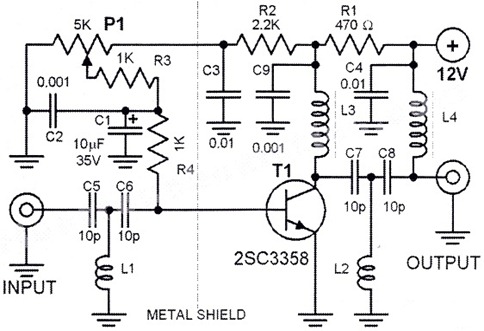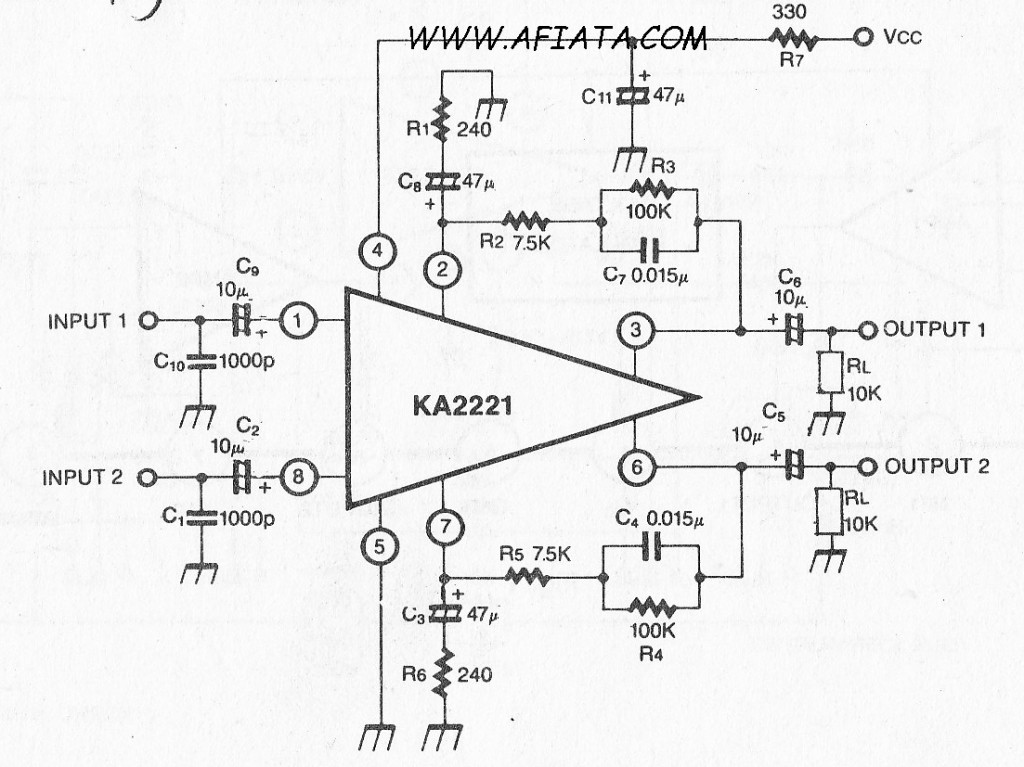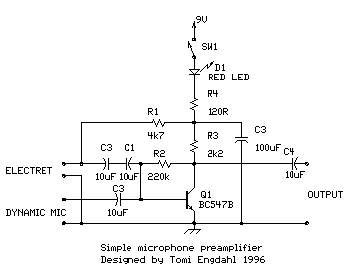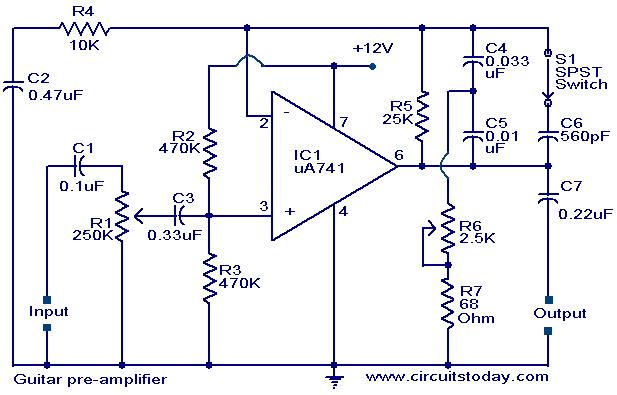
Guitar Amplifier
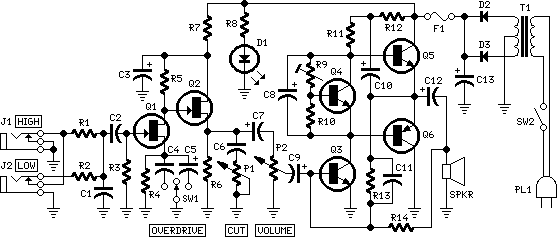
The objective of this design was to create a combo amplifier reminiscent of those commonly found in the 1960s and 1970s. This amplifier is particularly suitable for guitar applications but can also effectively amplify any electronic musical instrument or microphone. A 5W power output was a standard feature of these popular devices, attributed to the prevalent use of a class A single-tube output stage, similar to the Vox AC-4 model. Additionally, the design omits the outdated Vib-Trem feature often present in earlier models. The current circuit is capable of delivering 10W of output power when connected to an 8 Ohm load, and approximately 18W when connected to a 4 Ohm load. It includes a two-FET preamplifier, offers two inputs with varying sensitivity, a treble-cut control, and an optional switch for overdrive or enhanced treble. In configurations where Darlington transistors serve as output devices, it is crucial for the sensing transistor (Q4) to maintain close thermal contact with the output transistors. Consequently, a TO126-case transistor type was selected for its ease of mounting on the heatsink, positioned near the output pair.
The combo amplifier circuit integrates a two-stage design that enhances audio fidelity and versatility. The two-FET preamplifier stage is responsible for amplifying the input signal while maintaining low noise levels, which is essential for high-quality sound reproduction. The choice of FETs allows for high input impedance, making the amplifier suitable for a variety of input sources, including passive guitar pickups and microphones.
The amplifier features dual inputs, each designed for different sensitivity levels. This allows performers to connect various instruments without the need for additional gain stages or external preamps, facilitating a user-friendly experience. The treble-cut control provides tonal shaping, enabling users to tailor their sound to suit different musical styles and preferences.
The output stage employs a Darlington transistor configuration, known for its ability to deliver high current gain and efficiency. The integration of the sensing transistor (Q4) in close proximity to the output transistors ensures accurate temperature monitoring, which is critical for maintaining the reliability and longevity of the amplifier. By utilizing a TO126-case transistor, the design simplifies the thermal management process, allowing for effective heat dissipation.
Overall, this combo amplifier design not only pays homage to the classic models of the past but also incorporates modern advancements to enhance performance and usability, making it a versatile choice for musicians and audio enthusiasts alike.The aim of this design was to reproduce a Combo amplifier of the type very common in the `sixties and the `seventies of the past century. It is well suited as a guitar amplifier but it will do a good job with any kind of electronic musical instrument or microphone.
5W power output was a common feature of these widespread devices due to the general adoption of a class A single-tube output stage (see the Vox AC-4 model). Furthermore, nowadays we can do without the old-fashioned Vib-Trem feature frequently included in those designs. The present circuit can deliver 10W of output power when driving an 8 Ohm load, or about 18W @ 4 Ohm.
It also features a two-FET preamplifier, two inputs with different sensitivity, a treble-cut control and an optional switch allowing overdrive or powerful treble-enhancement. In all cases where Darlington transistors are used as the output devices it is essential that the sensing transistor (Q4) should be in as close thermal contact with the output transistors as possible.
Therefore a TO126-case transistor type was chosen for easy bolting on the heatsink, very close to the output pair. 🔗 External reference
The combo amplifier circuit integrates a two-stage design that enhances audio fidelity and versatility. The two-FET preamplifier stage is responsible for amplifying the input signal while maintaining low noise levels, which is essential for high-quality sound reproduction. The choice of FETs allows for high input impedance, making the amplifier suitable for a variety of input sources, including passive guitar pickups and microphones.
The amplifier features dual inputs, each designed for different sensitivity levels. This allows performers to connect various instruments without the need for additional gain stages or external preamps, facilitating a user-friendly experience. The treble-cut control provides tonal shaping, enabling users to tailor their sound to suit different musical styles and preferences.
The output stage employs a Darlington transistor configuration, known for its ability to deliver high current gain and efficiency. The integration of the sensing transistor (Q4) in close proximity to the output transistors ensures accurate temperature monitoring, which is critical for maintaining the reliability and longevity of the amplifier. By utilizing a TO126-case transistor, the design simplifies the thermal management process, allowing for effective heat dissipation.
Overall, this combo amplifier design not only pays homage to the classic models of the past but also incorporates modern advancements to enhance performance and usability, making it a versatile choice for musicians and audio enthusiasts alike.The aim of this design was to reproduce a Combo amplifier of the type very common in the `sixties and the `seventies of the past century. It is well suited as a guitar amplifier but it will do a good job with any kind of electronic musical instrument or microphone.
5W power output was a common feature of these widespread devices due to the general adoption of a class A single-tube output stage (see the Vox AC-4 model). Furthermore, nowadays we can do without the old-fashioned Vib-Trem feature frequently included in those designs. The present circuit can deliver 10W of output power when driving an 8 Ohm load, or about 18W @ 4 Ohm.
It also features a two-FET preamplifier, two inputs with different sensitivity, a treble-cut control and an optional switch allowing overdrive or powerful treble-enhancement. In all cases where Darlington transistors are used as the output devices it is essential that the sensing transistor (Q4) should be in as close thermal contact with the output transistors as possible.
Therefore a TO126-case transistor type was chosen for easy bolting on the heatsink, very close to the output pair. 🔗 External reference
